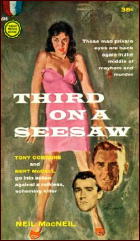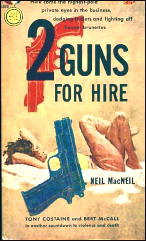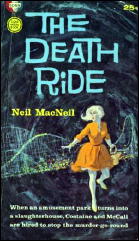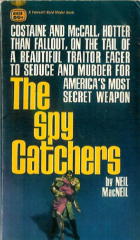June 2009
Monthly Archive
Wed 24 Jun 2009
THREE FROM THE SMALL SCREEN, PART 3.
Movie Reviews by David L. Vineyard
Previously on this blog:
Part 1: How I Spent My Summer Vacation (1967).
Part 2: Run a Crooked Mile (1969).
PROBE. Warner Brothers/NBC-TV; 13 September 1972. Hugh O’Brien, Elke Summer, John Gielgud, Lilia Skala, Burgess Meredith, Angle Tompkins, Kent Smith. Alfred Ryder, Ben Wright. Teleplay: Leslie Stevens; director: Russell Mayberry.
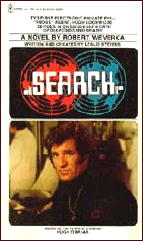
This was the clever pilot film for the TV series Search (1971-1973), a sort of updated cross between The Man From U.N.C.L.E. and the first season of Mannix.
O’Brien was Hugh Lockwood, a suave headstrong operative of World Securities, a high tech firm that implants sophisticated audio and physical monitoring devices in its agents and supplies them with a miniature camera worn either as a ring or on a gold chain around the neck (it was the seventies after all).
Monitoring Lockwood is B. C. Cameron (Meredith) an armchair genius who envies his agents the good life they lead between dangers; Dr. Laurent, the companies founder (Kent Smith); and technician Gloria Hardy (Angel Tompkins), who provide Lockwood with intel and expertise for his missions.
In this pilot film, Lockwood is teamed with famed diamond expert Harold Streeter (Gielgud) to find a cache of diamonds stolen at the end of WWII by a Nazi war criminal. Their only lead is the war criminal’s ex wife (Lilia Skalla) and daughter (Sommer). The mission takes them across Europe into the high life and face to face with an underground of Nazis wanting the diamonds for the new Reich, while they are stalked by the shadow of the war criminal Ullman.
Lockwood proves a smart capable agent with a penchant for following his own head and turning off both his lifeline and camera, to the annoyance of Cameron who sees the agents as little more than his eyes and ears.
The plot works up to a nice twist that you will probably see coming, but is done so smoothly by the superior cast that it hardly interferes with the entertainment.

Alas, the series added two other agents: Tony Franciosa and Doug McClure, and it never reclaimed the style or the charm of the pilot film. But then it would be hard to have guests like Gielgud, Sommer, and Skala every week. It ran one season and was gone.
But the pilot film stands on its own and is as good as many theatrical features. O’Brien is charming as a cross between James Bond and Milo March and the supporting cast is excellent. Meredith is a delight as the acerbic gourmand and polymath Cameron, and his war of affectionate disdain with O’Brien’s Lockwood is a delight.
A novelization of the pilot film by Robert Wervka was published by Bantam as Search.
In conclusion:
All three of these superior made-for-television movies this series of columns has covered deserve to be available on DVD.
While much of what came out of the made-for-television movie craze was either dreck, bad remakes of theatrical features, or over praised soap opera designed to squeeze tears and social issues, there were some entertaining films that deserve to be seen and remembered for doing what the small screen does best — produce light entertainment that lingers on when we have forgotten more important fare.
Tue 23 Jun 2009
RED LIGHT. United Artists, 1949. George Raft, Virginia Mayo, Gene Lockhart, Raymond Burr, Harry Morgan, Barton MacLane, Arthur Franz. Music: Dmitri Tiomkin. Director: Roy Del Ruth.
First of all, I have little or no idea what the title of this semi- or quasi-noirish movie means. And second of all, I’m not sure that the people who made this movie had a well-conceived idea about what kind of movie they wanted to make. (Or perhaps if they did, it’s one that doesn’t square away with the kind of movie I wanted them to make, in which case the problem is mine, and not theirs.)
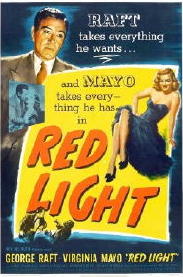
While I stand to be rebutted on this, I found this film to be schizophrenic to an extreme. With Raymond Burr and Harry Morgan playing two of the most utterly nasty villains ever to appear on the screen, at least at the time of its first showing, this movie also contains some of the most vividly noirish scenes (dark alleys, neon signs, rainy rooftops, grotesque close-ups) to be seen in the entire first generation of the genre.
And yet, the message of the film is a spiritual if not totally religious one, one that leaves vengeance to an all-powerful heavenly being, complete with a spirited — if not overpoweringly uplifting — musical background provided by Dmitri Tiomkin.
To me, though, the musical score was intrusively inappropriate and working dramatically (and loudly) at cross-purposes against the darker images and story being portrayed on the screen.
George Raft plays Johnny Torno in Red Light, the co-owner of a medium-to-large trucking company. Several years before he was responsible for the imprisonment of company embezzler Nick Cherney (Raymond Burr), who upon his impending release from prison hires Rocky to kill Torno’s brother, a priest just returned to the US after a stint as a wartime chaplain.
At which point the movie also becomes a “dying message” mystery, for the dying man’s last words are, “In the Bible,” initiating a hunt by Torno for the subsequent guests in his brother’s hotel room, once Torno realizes that the Gideon Bible that was in it is missing.
One of these guests is Carla North (Virginia Mayo), whose presence in the movie is needed, I suspect, only because otherwise there would be no women in it. Why Torno hires her to aid him in finding the other guests is not entirely clear, save for a jarring coincidental wartime connection between him and her through his brother.
There are other major holes in the plot, often safely ignorable, and you might even call them minor, but major or minor, sometimes holes bother you, and sometime they don’t. This time, they did, perhaps because in the best of times, I’m not a George Raft fan, and even Virgina Mayo’s role in this movie I found too bland and watered down for my tastes.
If it weren’t for Raymond Burr and Harry Morgan (at the time still called Henry Morgan) I’d have to call this film totally ordinary, or even a notch or two less. But sometimes it takes a villain or two to make a movie memorable, and in this case, that’s precisely what this perfect pair of sadistic hoodlums did.
Tue 23 Jun 2009
REVIEWED BY WALTER ALBERT:
JO DERESKE – Miss Zukas and the Library Murders. Avon, paperback, 2006. Originally published by Avon as a paperback original in 1994.
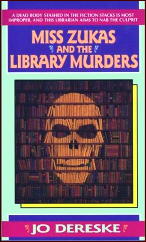
Miss Zukas is a middle-aged, spinsterish librarian in Bellehaven, Washington, a transplanted Lithuanian from the upper Midwest. She’s fairly rigid, certain of her “rightness,” and largely intolerant of the masses, who include most of the people she works with or comes into contact with.
She reminded me of a librarian in the Little Rock Public Library who — without saying a word — communicated her disapproval of a Peter Arno collection with one of Arno’s scantily clad females on the book’s jacket that I checked out from the Little Rock Public Library when I was a warty teenager.
In spite of Miss Zukas’ thorny personality (or maybe because of it), I rather enjoyed this low-key mystery. The library setting and staff seem real, and I reflected that a protagonist who irritates me probably suggests the writer has some skill at characterization.
There’s a cop who’s somewhat attracted to Miss Z. (whether she’s attracted to him is not very clear, but she doesn’t come across as introspective), a bohemian artist friend (Ruth) whose track record in men is deplorable, and a tendency in Miss Z. to withhold vital evidence from the police that puts both her and Ruth and the solving of the case at risk.
Will I read another in the series? I’m not sure.
Editorial Comment:
There are eleven books in the Miss Zukas series, of which Library Murders is the first. There’s a complete bibliography for Jo Dereske’s mystery fiction on this blog back here where I reviewed #6, Final Notice.
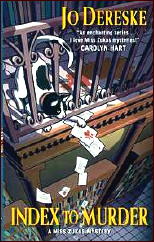
I called reading it a “sneaky pleasure,” and otherwise agreeing in all essentials to all of Walter’s observations. Although I’ve not read more than two or three books in the series myself, I fully intend to get to all of them, eventually.
When I sent a copy of that earlier review to Jo Dereske, I also asked her about the rumors I’d heard that #11, Index to Murder (2008) was going to be the last appearance of Miss Zukas.
Here’s her reply, in part:
“As to what you’ve heard about Miss Zukas’s future, you are correct. At the moment, there isn’t another contract for more adventures, but who knows what the future may bring. She’s been such a fun character to portray. I’m currently working on another series which my agent is shopping around.
“Congratulations on your blog. I’ll put a link to it in my next website update.”
Tue 23 Jun 2009
REVIEWED BY DAN STUMPF:
THE PAINTED TRAIL. Monogram, 1938. Tom Keene, Eleanor Stewart, LeRoy Mason, Walter Long, Frank Campeau, Jimmy Eagles. Story by Robert Emmett Tansey; director: Robert F. Hill.
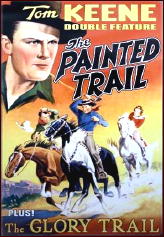
A thoughtful director can bring a lot to a movie, even a B-picture like The Painted Trail, a fast-paced Tom Keene western with surprisingly arty tinges from a studio that mostly did its movies penny-plain.
This one gives us the usual thing of a lawman going undercover (as the Pecos Kid) to thwart an outlaw gang operating on the Mexican border and coming up against baddies LeRoy Mason and Walter Long — a real veteran, who in palmier days menaced Lillian Gish in Birth of a Nation and played Miles Archer in the first film of The Maltese Falcon.
There’s also a nice bit by an unknown actor named Jimmy Eagles as a desperate wanna-be fingered for extinction by the tough guys he wants to impress; it’s an energetic, touching job that should have led to bigger things, but Monogram was always a studio where actors ended-up rather than started-out.
Director Robert F. Hill takes all this and runs through it with commendable speed. Hill was never known for artistry — he’s remembered if at all for helming Flash Gordon’s Trip to Mars and the silent Adventures of Tarzan with Elmo Lincoln — but he throws in a couple moments here that make one wonder: there’s a clandestine meeting in a mostly darkened room, and at the end of the scene a character extinguishes the only lamp, plunging the screen into darkness: a simple yet stylish alternative to the standard fade-to-black.
Best of all, the climax finds Tom Keene and Walter Long approaching each other for a shoot-out walking along opposite sides of a chicken-wire border fence, and Hill shoots this from every possible angle to maximize the visual play of the fence against the gunmen.
It’s a startling, tense and eye-catching few minutes in a film that deserves a second look.
Tue 23 Jun 2009
A 1001 MIDNIGHTS Review
by Marcia Muller:
JOSEPH WAMBAUGH – The Choirboys. Delacorte, hardcover, 1975. Reprint paperback: Dell, 1976. Reprinted many times since. Film: Lorimar, 1978; screenwriter: Christopher Knopf; director: Robert Aldrich.
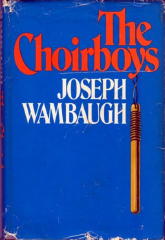
The powerful opening of this novel takes place in a cave in Vietnam in 1967. Two unnamed marines have taken shelter there from the enemy, and one of them suffers a severe emotional break. Although we do not learn their identities until much later in the book, we can surmise that this incident provides the fuel for future tragedy.
The scene then shifts to Los Angeles nearly ten years later The “choirboys” are a group of policemen who attend “choir practice” — otherwise known as drinking binges — in MacArthur Park after going off night duty . We are told that a tragedy has taken place during one of these sessions and that a young man has been shot to death.
Wambaugh then goes into flashback and takes us through the months prior to this final choir practice, introducing us to the participants, allowing us to glimpse their routine — and not-so-routine — tours of duty.
We come to know intimately such characters as Roscoe Rules, the meanest and probably most despicable man in the precinct; Aaron Mobley, a twenty-five-year-old alcoholic who somehow still manages to function on the job; Francis Tanaguchi, a Nisei who feels more Mexican than Japanese; Spermwhale Whalen, a veteran cop who has a big stake in making it to his twenty-year retirement date; Sam Niles and Howard Bloomguard, physical opposites who nonetheless complement one another as partners; Spencer Van Moot, who can wangle a “freebie” out of any merchant he meets; Baxter Slate, whose “different” quality is hard for his fellow cops to pin down.
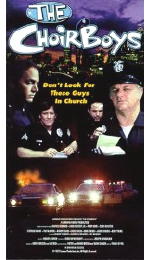
With frequent black humor, Wambaugh shows us both the strengths and weaknesses of his characters, as well as the daily strains, sordidness, and departmental hypocrisy with which they must cope. And when tragedy finally befalls them, the only surprise is that it hasn’t happened sooner.
This is a first-rate novel that goes several steps beyond the standard police procedural. It was filmed in 1977, starring Charles Durning and Perry King. Among Wambaugh’s other novels of the police world are The Black Marble (1978) and The Secrets of Harry Bright (1985).
———
Reprinted with permission from 1001 Midnights, edited by Bill Pronzini & Marcia Muller and published by The Battered Silicon Dispatch Box, 2007. Copyright © 1986, 2007 by the Pronzini-Muller Family Trust.
Mon 22 Jun 2009
Posted by Steve under
Reviews[2] Comments
NGAIO MARSH – Enter a Murderer. Pocket 113, paperback reprint; 1st US printing, July 1941. Previously published in the UK by Geoffrey Bles, 1935. Reprinted many times, in both hardcover and soft, including (and shown): Berkley F703, US, 1963; Fontana, UK, pb, 1968, 1983; St.Martin’s, US, pb, 1998.
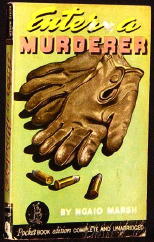
I’m far from being an expert on Ngaio Marsh, so I can’t tell you what the circumstances were that Enter a Murderer was published for the first time in the US as a Pocket Book paperback, and not as a hardcover. But I imagine the story’s known, and perhaps someone reading this who can fill in the details will do so. (I’ve found nothing on the Internet so far that’s relevant.)
Enter a Murderer was only her second novel, which may be part of the explanation, and the first of five detective novels Marsh wrote which took place in the world of the theater, one of the loves of her own long life. (She was born in 1895, most reference sources say, and passed away in 1982.)
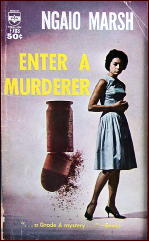
Dead is an actor, shot to death onstage, with dummy bullets having been replaced with live ones in the gun another actor used as part of the play, with the two directly facing each other.
That the dead man was a blackmailer (as it is soon discovered), a womanizer and a thwarted lover (as was well known), plus various and sundry other flaws, gives a motive to everyone on or near the stage. A blackout to open the final act gave everyone an opportunity.
The investigation that results, carried out by Chief-Det. Inspector Alleyn (primarily) and his assistant on the case, Inspector Fox (secondarily), is both aided and abetted by news journalist Nigel Bathgate, a friend of Alleyn whom he invited to the play, which they watched together to its final and deadly conclusion.
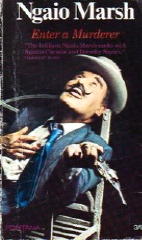
It’s not always an easy relationship. Bathgate is willing to let Alleyn censor his reporting, but he’s not always inclined to ask potentially embarrassing questions of friends who happen to be under suspicion.
Sometimes the investigation (from the reader’s point of view) is told with Alleyn as the protagonist, and sometimes it’s from Bathgate’s point of view. It’s a combination that Marsh may have thought she needed to present the story more efficiently from several angles, but it’s not as smoothly done as I thought it might have.
The action in and around the stage is clearly delineated, though, many times over, even to a final reconstruction of the crime at the end – always a welcome touch in classical detective fiction, resembling as it does the “isolated country house” theme in certainly the most essential way.
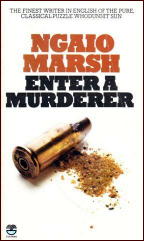
But the business of the blackmail never seems to be addressed directly. It’s as if it were shunted to the side, not abruptly, but Marsh never seems to tackle it head on, leaving the motive for the killing murky, while a full spotlight is shed upon the setting. (At times you can all but smell the greasepaint.)
Upon finishing the book I was more than satisfied with the solution – nicely done – but I’m still uneasy about there being some loose ends that I didn’t (and still don’t) feel as though they were wrapped up properly enough.
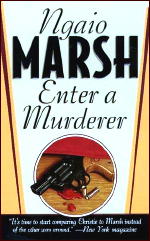
This has nothing to do with the actual solution, mind you. I like the ending well enough that I haven’t felt the need to poke around into that pile of red herrings stacked over there in the corner (figuratively speaking). It’s just the sense that I ought to, in order to give you an honest report.
But I’ve decided not to – go back through the book and poke around, that is – and what you’ve just read is as honest as it’s going to get.
Do I recommend the book? Yes, I do, but I assume you’ve already read and recognized all of the caveats (both major and minor) for what they’re worth as well.
Mon 22 Jun 2009
Neil McNeil’s Tony Costaine and Bert McCall Series
by DAVID L. VINEYARD
Between 1959 and 1966 Black Mask veteran Willis Todhunter Ballard penned seven books as Neil McNeil for the Gold Medal line of paperback originals about a pair of private eyes named Tony Costaine and Bert McCall:
Death Takes an Option. Gold Medal 807, pbo, September 1958.
Third on a Seesaw. Gold Medal s844, pbo, January 1959.
2 Guns for Hire. Gold Medal s898, pbo, July 1959.
Hot Dam. Gold Medal 964, pbo, January 1960.
The Death Ride. Gold Medal 1055, pbo, November 1960.
Mexican Slayride. Gold Medal s1182, pbo, January 1962.
The Spy Catchers. Gold Medal d1658; pbo, 1966.
Though the series was never a major hit, they are highly entertaining superior light private eye fiction much in the mood and style of such popular series as 77 Sunset Strip and Peter Gunn on television. Costaine and McCall are the epitome of the cool, hip, buttoned-down PI’s of the period, distilled through the Rat Pack school of middle aged hipster, a group of slick eyes that rode the wave between Mike Hammer and James Bond.
Anthony “Tony” Costaine is the brains of the outfit, slick, smart and tough, the button-down collar Brooks Brothers suit half of the team, who first teamed up with McCall back in their FBI and OSS days, six lean feet of muscle and brains.
Bert McCall, a giant handsome Scot (born in Scotland) and topping six feet six in his stocking feet is the other half of the team, a born hedonist with an eye for the ladies, and a penchant for finding trouble and playing the bagpipes. Between the two of them they are the highest paid eyes of their day — so as you can imagine their clients tend to be rich, powerful, and in big trouble.
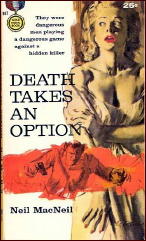
In Death Takes an Option Marcus Cadby has hired them to find out why the auditor of MidContinental Mine and Machine commited suicide, but not before his younger and very sexy wife has tried to pry information out of Costaine.
Then no sooner than their plane touches down in Los Angeles someone takes a pot shot at them, and before long they are involved with murder, a trip to Vegas, and a slick plot twist you will have to read for yourself.
The trip to Vegas is important, because Costaine and McCall are, as I suggested above, Frank and Dino in not very subtle guise. McCall even calls Costaine “Dad.”
Third on a Seesaw takes them to Reesedale PA, home of Reese Steel and Tube Company where they clean up the town and a murder — once McCall can be pried away from his bagpipes.
2 Guns for Hire involves the boys with the car industry and a beautiful woman who paints nudes, and in Hot Dam they encounter a whole community of distant relatives of McCall who are sabotaging a power company by trying to build a dam that will flood their homes in upper New York state.
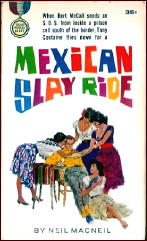
The Death Ride takes them into the business of amusement parks, and in Mexican Slay Ride McCall ends up in jail south of the border as the boys take on a job involving fraud and the Mexican government. The Spy Catchers mixes them in with the government and treason in the aerospace industry and secret weapons.
To be fair, Ballard could do this kind of book in his sleep, but thankfully he doesn’t. The boys are cool and smart, McCall just dumb enough to get them in trouble and Costaine just smart enough to get them out.
There is a parade of attractive women varying from willing to murderous (and sometimes both), and a wide variety of action. The books aren’t major works or anything, but they are good and well worth discovering. Plotting is better than it had to be, and Costaine and McCall are always fun to be around.
● McCall liked his women to be married as long as they weren’t married to him.
● Tony Costaine was surprised. He could not remember being as surprised since the night the Chinese girl had walked into his Singapore apartment carrying a Tommy gun.
● “In that case it’s simple,” McCall licked his lips. “We make motions, we find nothing, and we trot back to Cadby and say we are sorry.”
“And lose the twenty thousand he’ll owe us when we come up with his answer? Besides it wouldn’t be ethical.”
McCall opened his eyes very wide. “I don’t dig the word, Dad. Where’d you ever hear it?”
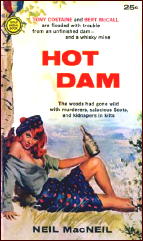
● Wearing a black flat topped Mexican hat with tiny read balls dangling and dancing from its brim, Norbert McCall, Scotland’s contribution to the atomic age, did not look like a man who was out on fifty thousand dollars’ bail.
● “I’m never in trouble,” Anthony Costaine said with conviction. He had had five drinks. He sounded as if he meant it.
● “Whoever’s got it (the secret weapon) is playing for keeps, and the price is the peace of the world.”
McCall yawned. “Aw, it’s probably only Goldfinger.”
Ballard was one of the original Black Mask Boys with his tales of movie studio troubleshooter Bill Lennox (who also featured in three novels published as by Ballard and John Shepard), and a frequent collaborator with Robert Leslie Bellem and Cleve Adams.
He wrote for early television (Dick Tracy) and even wrote a non genre novel about his experiences. Under his own name and as P.D. Ballard and Todhunter Ballard, among others, he wrote well-received westerns, and under the W.T. Ballard name, three books about Lt. Max Hunter of the Las Vegas police.
His last novel, Murder in Las Vegas, about private eye Mark Foran, is one of the better hardboiled paperback originals of its period.
That Todhunter is a family name. He was a cousin of Rex Todhunter Stout.
Costaine and McCall may not be in the top tier of private eyes, but they are well worth discovering. The writing is lean and slick, and the action comes fast and furious. A little action, a soupcon of sex, and a twist or two in the tale are more than enough to recommend these.
They make good company, and fit right in with Shell Scott and Chet Drum. Make the effort to meet them, but first lock up the Scotch and the women. You just can’t trust that McCall with either.
Mon 22 Jun 2009
MICHAEL UNDERWOOD – Crooked Wood.
St. Martin’s, US, hardcover, 1978. Hardcover reprint: Detective Book Club, 3-in-1 edition, July 1978. Previously published in the UK by Macmillan, hc, 1978.
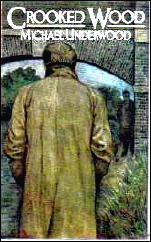
Mystery stories usually end where this one begins, with the murderer safely behind bars and about to stand trial. Underwood’s forte is the courtroom drama, British style, and here the problem is twofold: who hired the contract killer who actually did the job, and, who’s trying to buy off one of the jurors?
Sergeant Atwell’s work is clearly not done, and it requires the timely assistance of his ex-policewoman wife Clare and the gathering of an overabundant supply of red herrings before a surprise Mr. X is named. A deftly woven detective tale it is, and an interesting variation from the norm.
– From The MYSTERY FANcier, Vol. 3, No. 3, May-June 1979, very slightly revised.
Bibliographic data:
Michael Underwood was the pen name of John Michael Evelyn, 1916-1992, and the author of nearly 50 works of crime and detective fiction, many of them dealing with cases taking place in British courtrooms in one way or another.
His series characters include (often in overlapping cases) Inspector (later Superintendent) Simon Manton, Martin Ainsworth, Rosa Epton, Richard Monk and Sergeant Nick Atwell. One bookseller describes Rosa Epton as “England’s answer to Perry Mason.”
Richard Monk is also a lawyer, but the books with Martin Ainsworth appear to be spy fiction (e.g. The Unprofessional Spy, 1964). Many of the cases for Nick Atwell, a police sergeant at Scotland Yard, are shared with detective constable Clare Reynolds, although according to my review, she seems to have been off the force at the time Crooked Wood takes place.
Sun 21 Jun 2009
ADVENTURE IN MANHATTAN. Columbia, 1936. Jean Arthur, Joel McCrea, Reginald Owen, Thomas Mitchell. Suggested by the story “Purple and Fine Linen” by May Edginton. Director: Edward Ludwig.
There are actually two stories involved in this moderately entertaining crime-romance trifle. The first is kind of a story within the story, if you will, and it’s the one by May Edginton listed in the credits. But I’ll back up a little, though, before saying more.
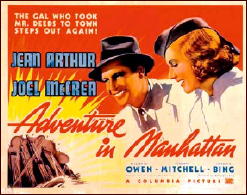
Hot shot crime reporter George Melville (Joel McCrea) is one of those fellows the rest of the guys on the beat love to hate. While he gets along with them fine, he’s by nature smug and self-possessed, and for good reason. He gets scoops that no one else does, not by chance, but by pure intellect and a dispassionate viewing of the facts.
If a good-looking woman comes along when he’s working on a story, she’d just be another clue, he is ribbed, and he good-heartedly agrees. But when a good-looking woman does come along (Jean Arthur), he falls for her story hook, line and sinker, just like every other guy would. Or is it a story? Well, it’s the one I mentioned by May Edginton above, and it’s a good one.
You can even read the entire story online right here. It will suck you in too, I guarantee, a tale of a young woman down on her luck who has to resort to picking pockets in order to see her young girl who’s been living with her father and whom the mother has not seen since the divorce went through.
This first part of the movie takes up no more than twenty minutes of the film, and while I hate to say it, given that I like both Jean Arthur and Joel McCrea as actors, but it goes downhill from here. I also say that even though the second half of the film is one of those grand high-stakes art theft movies I was talking about in regard to crime caper fiction not so long ago.
What the segue is, and how the story makes the switch from the first part of the movie to the second, I will leave for you to watch (and enjoy) on your own.
I think what the problem is, relative to the second half of the film, though, is that there’s too much story and not enough plot — and there’s somehow not enough time left to explain (convincingly) what the attraction between the two leading players is, other than that she’s a woman and he’s a man, and of course the twain have to meet.
Nonetheless, moderately entertaining is what I said up above, and I’ll stand by what I said. But in terms of simple comparisons, if you’re a fan of romantic comedies, The More the Merrier (1943), with (quite coincidentally) the same two stars, this movie is not. Given a choice and a chance, I’d watch that one instead — any time — even if there’s no crime in it.
Sun 21 Jun 2009
Posted by Steve under
Authors ,
ReviewsNo Comments
REVIEWED BY WALTER ALBERT:
VENA CORK – The Art of Dying. Headline, UK, hardcover, 2005; paperback, 2006.
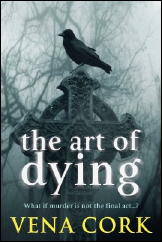
In Thorn (2004), previous to the events taking place in this follow-up novel, Rosa Thorn lost her husband, celebrated Jamaican-born artist Rob Thorn, in a hit-and-run accident, then found that her daughter was being stalked by a shadowy figure who turned their life into a nightmare.
Now, in The Art of Dying, in the wake of an exhibition of her husband’s last paintings, Rosa herself is stalked by a mysterious figure who she discovers is the half-brother of her late husband. Rosa accepts Joshua into her family but becomes increasingly concerned that he’s something other than the loving brother-in-law he initially appears to be.
Rosa’s relationship with Josh is not her only problem, as all of her personal relationships seem to be foundering in misunderstandings and hidden agendas.
This psychological thriller eventually climaxes in a gothic underground nightmare that some readers may find over the top. I rather enjoyed the plot’s ghoulish turn, but I hope that Cork will let Rosa and her family live out their fictional lives in private, without the perilous complications that could confirm that a series is underway.
EDITORIAL COMMENT. There is a third book in the series, Green Eye (2006), in which Rosa Thorn also appears, but there seems to have been nothing from Vena Cork’s keyboard in the three years since. The books are available in the US only as import editions.
From the Tangled Web site: “Vena Cork is from Lancashire, but has lived in London all her adult life. She attended Homerton College, Cambridge, where she was a member of Cambridge Footlights. She is married to the art critic Richard Cork and lives in North West London.”
« Previous Page — Next Page »













